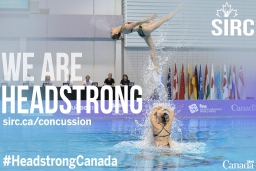Innovative Research is Reducing Concussion Risks for Artistic Swimmers
Wednesday, July 10, 2019 - 03:00

Most Canadians would not consider artistic swimming (formerly synchronized swimming) a contact sport. But ask an athlete or coach, and they will tell you it can get pretty intense.
“Especially in the team events, there are athletes in very close proximity, performing fast, explosive choreography,” explains Jackie Buckingham, Chief Executive Officer of Canada Artistic Swimming. “Spectators don’t necessarily see it, but there’s a lot of contact below the surface, with arms and legs moving around quickly and with tremendous power. Concussions are an issue we’ve been dealing with for years and we’re starting to make some really important breakthroughs.”
Buckingham says Canada Artistic Swimming has had a national concussion protocol in place since 2009. It has been updated several times based on reviews of concussion events and new research. A big part of the challenge is that athletes are put in very unique situations.
“They’re underwater and upside down in a hypoxic state (low levels of oxygen in the blood),” notes Buckingham. “That creates different kinds of risk for our athletes and also affects policies like ‘Return to Sport.’ There are pretty standard RTS protocols available for ‘typical’ sport situations but we’re far from typical.”
Canada Artistic Swimming has relied on leading Canadian resources and some innovative research to build one of the most progressive concussion prevention programs in the country. Starting with the Canadian Guideline on Concussion in Sport developed by Parachute, Canada Artistic Swimming has developed a comprehensive national package that features Return to Sport guidelines, educational materials targeting athletes, coaches and parents, along with a range of resources offered through an online hub hosted by the Sport Information Resource Centre (SIRC).
The SIRC site has become the “go to” destination for concussion research, tips and tools. With financial support from Sport Canada, the hub features the latest Canadian and international research as well as a suite of templates and sample products to help sport organizations at any level.
At the heart of awareness efforts are the “4 Rs” that give clear direction to everyone involved in sport –
1) Recognize the signs and symptoms of a concussion;
2) Remove the athlete from the game or practice;
3) Refer the athlete to a healthcare professional; and
4) Return to school and then to sport based on the recommendations of a physician.
On the research side, an injury tracking program has been set up in Ontario through a collaboration between Ontario Artistic Swimming and Laura McClemont Steacy, a PhD candidate from the University of Toronto. Now in its second full season, the program records the number and type of athlete injuries as well as information on the context (i.e. the when, where, and how of each injury). By monitoring injuries, including concussions, Canada Artistic Swimming can start to identify programming changes that could enhance athlete safety.
“The data has begun to point to links between concussion risks and the time of day, the time of the year, the particular point in a training plan, and even whether it’s the start or the end of a practice session,” says Buckingham. “Armed with this knowledge, we can be proactive in making changes to the training program to avoid putting our athletes in situations where they’re at greater risk of concussion.”
Canada Artistic Swimming will soon roll out an updated national concussion management protocol and policy with the goal of having it endorsed and used by all of its provincial and territorial associations. All of the material, including a suite of educational resources, will be available on its website.
RELATED
This blog is part of SIRC’s #HeadstrongCanada concussion awareness, prevention and management campaign. The campaign features tools, resources, and best practices in managing and preventing concussions in sport in Canada. Developed in partnership with Sport Canada, Public Health Agency of Canada and other organizations, the toolkit offers credible information and templates recognized by stakeholders throughout the sport system.
Check out the concussion website for concussion information and tools to help your sport be concussion smart. For concussion information directly to your inbox, sign up for SIRC’s concussion newsletter.